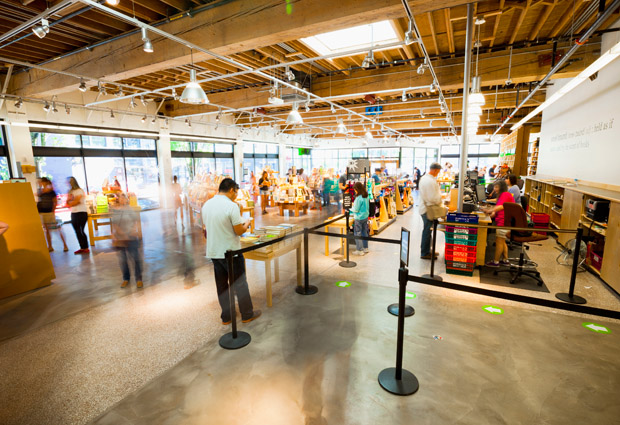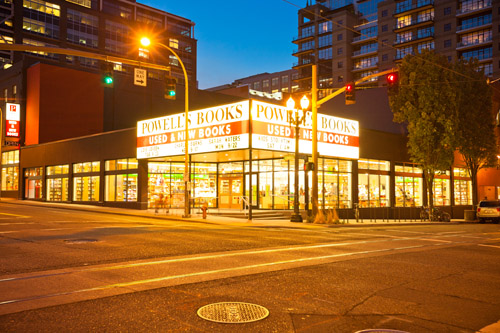BY JON BELL
Powell’s stays relevant in the digital age.

BY JON BELL
Portland bibliophiles who have long shopped and browsed at Powell’s flagship bookstore may have felt a little lost the first time they entered the store through the main entrance in August.
Gone were the gritty exterior, the cluttered and cramped Green Room entry, the leaky roof and the unseen seismic hazards. In their place, visitors found skylights, white space and a clean, airy, decidedly un-Powell’s-like aesthetic. But not all was rendered new through this long-overdue remodel. There were books, of course: new arrivals, staff picks, titles to read before you die. And hanging above the outside entrance, the old, familiar Powell’s Books marquee, a touch tired against the spruced-up facade of the city’s most treasured bookstore.
“I used to call it the ugly sign at 10th and West Burnside,” says Miriam Sontz, a nearly 30-year Powell’s employee who became CEO in 2013. “Now I call it the iconic sign at 10th and West Burnside.”
Powell’s summer makeover incorporates modern design elements while retaining some of the traditions that have been part of Powell’s since it was founded four decades ago. That blend also manifests itself in the bookseller’s business strategy: focusing on printed books and in-store sales while slowly embracing digital sales and e-books on a measured basis. The company has been gradually diversifying its mix — starting as a used bookseller, then adding new books in 1979, for example, or offering Kobo e-readers alongside print books in 2012 — for 43 years.
Given the supposed death of print and bookstores, it may come as a surprise to learn traditional books continue to drive business at Powell’s. Membership in the American Booksellers Association plummeted from 5,500 members in 1995 to 1,400 in 2009, and online book sales outpaced brick-and-mortar sales for the first time in 2013. But according to Sontz, these trends mask important distinctions between bookstores.
“I am so tired of people asking us, ‘Why are you not dead yet?’” she says. “Bookselling is not dead. Borders went down, but that was mismanagement, not that print was dying.”
Print and in-store sales are still king at Powell’s, Sontz says. Online sales account for about 20% of overall sales, a percentage that has held steady in recent years. E-books, too, continue to be just “a small piece of our business,” she adds. The Burnside store alone has about a million books in its inventory at any given time, and the Powell’s Hawthorne store, the second-smallest of its five locations, has an inventory of 200,000 books — double the size of the average Barnes & Noble.
That’s not to say that Powell’s hasn’t struggled alongside its industry peers. Diminishing sales led to 31 layoffs in 2010, and Sontz says it’s taken at least two years to fully rebound from the recession. Earlier this year, the company closed two of its three airport locations when the Port of Portland opted not to extend its lease. And, of course, Powell’s and other independent bookstores, as well as publishers, face stiff competition for people’s attention from ubiquitous social networking and streaming technologies.
Then there’s Amazon, which continues to pose a major threat, undercutting independent bookstores by offering massive discounts on books. In early September, a new hardcover copy of Peter Stark’s Astoria was available at Powell’s for $27.99; it was $17.70 on Amazon.
“It would be disingenuous not to acknowledge that Amazon is not a challenge,” says Oren Teicher, CEO of the American Booksellers Association. “It’s problematic that it reaches so far into our culture . . . and their tactics have not been good for the book business.”
Powell’s, though, still has solid material to work with. A draw for tourists and book lovers alike, the bookstore also benefits from the region’s die-hard buy-local ethos. E-book sales actually flattened out last year, and Teicher says publishers have begun offering increased support to bookstores in the form of more favorable business terms, and more efficient restocking.
 “Our colleagues in publishing need brick -and-mortar stores as much as stores need them,” he says.
“Our colleagues in publishing need brick -and-mortar stores as much as stores need them,” he says.
Not that Powell’s eschews technological change. While Sontz admits that Powell’s may not qualify as a 21st-century innovator, digitizing and updating the store’s inventory system has made a huge difference in online sales and in locating specific titles for specific readers. Powell’s social media presence is also huge, and the company has demonstrated a decidedly modern ability to turn controversies into marketing opportunities.
A case in point: In June Stephen Colbert plugged Edan Lepucki’s first published novel, California, on his show and urged people to buy it from Powell’s instead of Amazon — a jab at the online giant over a pricing dispute with Colbert’s own publisher, Hachette Book Group. Powell’s had the author sign 10,000 copies; 9,000 of them sold in advance.
Then there’s the fact that people keep moving to Portland; younger, well-educated people who like to read. It’s yet another glimpse at how blending the old and the new continues to work for Powell’s.
“A lot of people complain about all the folks who move to Portland. I’m not one of those people,” Sontz says. “Build those buildings and bring them here. It’s good for us and it’s good for the city. The bookstore is going to be here a long time. My grandkids are going to be shopping here.”


